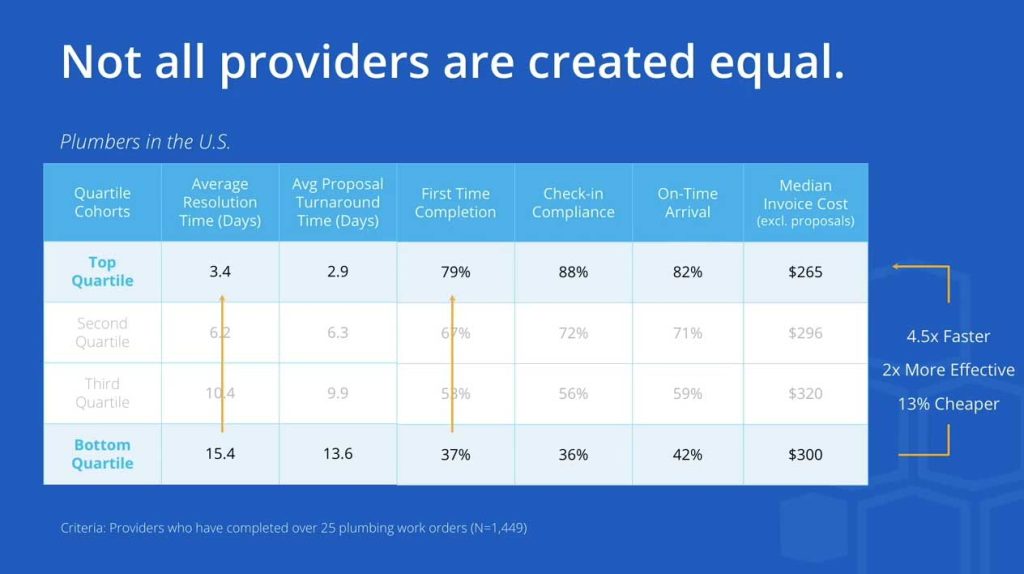The Complete Guide to Asset Inventory Management

Discover how modern asset inventory management software can benefit your business. Learn how to select, implement, and use an asset management system.
Asset inventory management is the term for how you track, monitor, and maintain physical and digital assets that your organization owns. For any facility manager overseeing multiple locations, asset management is crucial for operational efficiency.
Monitoring and maintaining all your assets effectively also helps you make more informed decisions about capital expenditures. As a result, asset inventory management can positively impact your bottom line.
Historically, manual asset tracking solutions, such as logbooks and spreadsheets, were the primary tools for asset management. However, these traditional methods can undermine efforts to closely manage assets. After all, manual asset inventory management processes fail to provide real-time visibility. They can also lead to data fragmentation and inaccuracies.
Due to the potential pitfalls of manual processes, asset management software has become an increasingly popular alternative. Here’s how your organization can successfully make the switch to a modern asset inventory management system and gain more control over your assets.
Building the Fundamentals of Asset Inventory Management
Before your organization can adopt a modern system for asset management, some preparation is necessary. Although these initial steps may take time and effort, building the fundamentals for asset inventory management is a one-time task.
An asset management platform requires a complete database of all digital and physical assets. As a result, you’ll need to create a complete, up-to-date inventory of current assets. Conducting a preliminary asset discovery audit can help you compile the list. The following are some asset details to include in your initial comprehensive inventory.
Asset Names
Each asset will need a unique name assigned using consistent naming conventions of your choosing. We’ll discuss naming your assets more later in this guide.
Asset Categories
Create a categorization system for your assets and assign each asset to the appropriate category. Example categories include:
- Software licenses
- Infrastructure assets
- Office equipment
- Medical equipment
- Computer equipment
- IT assets
- Vehicles
- Digital resources
Asset Locations
Provide the exact location for all physical assets. Using standard names for locations will make it easier to manage inventory in the future. For digital assets, list the storage location. For example, you might label cloud-based assets “cloud” or list the file path for assets stored on local servers.
Asset Values
In your initial asset inventory, include the following for each asset:
- Estimated replacement cost
- Original purchase price
- Current value with asset depreciation
Maintenance History and Manufacturer Information
Compile a list of all maintenance history for each of your physical and data assets. Your comprehensive asset inventory should also include the manufacturer’s service recommendations and warranty information.
Asset Conditions
The final asset data to include in your inventory is condition. Use a standardized system for describing the condition, such as:
- Decommissioned
- New
- In use
- Needs repair
- Out of service
Choosing the Right Asset Inventory Management Software
Today, your organization has many asset inventory management solutions to choose from. Fortunately, selecting one becomes easier when you compare software based on key characteristics, including the following.
Features
Before comparing asset inventory management solutions, assess your needs and goals. Then, look for asset management solutions with features that align with your requirements. Some key features that you may wish to prioritize include:
- Multi-location capability: If your organization has assets spread across multiple locations, ensure that you select software capable of managing assets in all of them.
- Data import tools: Software that enables you to bulk import information about multiple assets at one time can improve efficiency during the data entry phase of deployment.
- Automatic updates: Platforms that update automatically free your IT and security teams from the ongoing need to track and manage updates.
- Maintenance management features: Software that enables you to schedule and track service requests can minimize unscheduled downtime. It can also reduce the operational costs associated with unexpected emergency repairs.
- Maintenance inventory management support: Platforms that combine asset and inventory management software features allow you to keep parts inventories up to date with each work order performed.
Usability and Accessibility
Evaluate the interface of each asset inventory management solution. Intuitive, user-friendly software simplifies training and requires fewer technology resources for ongoing support. Also, check whether the software offers mobile capability. Programs that allow your team to access the platform from any location enhance efficiency.
Integrations
Integrating your asset inventory management software with other platforms can break down information silos. Determine whether solutions can integrate with programs you already use. Examples include Enterprise Resource Planning (ERP), IT Service Management (ITSM), and finance software.
Reporting and Analytics
Confirm that the software provides real-time data regarding asset utilization, value, condition, and status. Look for a program that offers custom reporting options that align with your needs. For example, your top priority may be accurate inventory forecasts or a simpler way to calculate asset depreciation.
Security
Examine the security encryption in place to protect your organization from data breaches. Also, determine whether the software limits access to sensitive data based on the roles you define and assign.
Compliance
Integrating compliance checks into your asset inventory management processes is important for risk management. Confirm that the software provides support for regulations in your industry.
Deployment
Asset inventory management solutions can be hosted locally or via cloud services. A cloud-based asset management system is generally quicker to deploy. It also often costs less because it eliminates the need for investments in servers and other technology.
Local deployment may be a better solution when organizational security policies limit the ability to utilize cloud services. A locally hosted platform may also be preferred when a lack of access due to frequent Internet outages is a major concern.
Support
Inquire about the level of support you’ll receive for the asset inventory management platform. When is technical support available? How can you get in touch with the customer support team?
Implementing Asset Management Technology
After selecting an asset management software solution, complete these steps to implement it:
- Initial data entry: Input the initial asset inventory information into the asset tracking system to create a centralized platform.
- Pilot program: Launch the asset inventory management system on a small scale. For example, service providers might track assets for one or two customers. Or, a company may begin using the system in a single location.
- Staff training: During the pilot program, train all staff members who will use the asset management software. Be sure to include all employees who will be responsible for asset maintenance and management.
- Integration: Integrate all desired systems with your asset management software. Conduct tests to ensure integration is complete.
- Phased deployment: Roll out the software company-wide incrementally to minimize the impact on daily operations.
Best Practices for Asset Tracking
Closely tracking assets can strengthen maintenance management. Effective tracking also ensures you have the data you need to assess asset performance and support informed decision-making. For effective asset inventory management, follow these best practices.
Standardize asset names
Taking a systemized approach when naming assets is essential to successful asset inventory management. Standardized names make searching for assets easier. They also lower the risk of duplicates and errors. To create standard names:
- Establish a clear structure: Choose a format to use for all names. For example, you might name assets [Asset Type] – [Location Code] – [Unique ID Number] or [Manufacturer Name] – [Model Number] – [Location Code] – [Unique ID Number].
- Create an abbreviation list: Abbreviations can simplify searches, but without standardization, they can lead to inconsistencies in your asset inventory management platform. Developing a list of approved abbreviations for specific types of assets eliminates confusion. For example, you might use SLIC for software licenses. Also, adopt standard abbreviations for all locations.
- Develop a naming policy: Write a formal company policy that outlines the naming conventions you select. Distribute the policy to everyone who will use your asset inventory management program.
Conduct regular audits
Conducting regular audits will enable you to maintain a clear, accurate picture of your asset landscape. During quarterly or biannual audits, verify each individual asset. Compare the information to the data in your asset inventory management platform.
Note discrepancies and identify missing and duplicate assets. Then, correct your asset inventory data accordingly. Analyze audit results to identify potential issues in your asset management processes.
Monitor the full asset lifecycle
Effective asset inventory management involves tracking the entire asset lifecycle. Even if initial asset discovery occurs years after you acquire an asset, enter the full history into your asset inventory management program. Continue tracking all assets until sale or disposal.
Use automation to reduce downtime
Automating preventative asset maintenance work order creation prevents missed calibrations, updates, and services. After the initial time investment required to set up schedules, automation eliminates the need for your team to regularly create manual work orders. It also helps to minimize downtime, so your critical assets are available when needed.
Utilize barcodes and IoT technology
Barcodes can speed up asset discovery and asset inventory updates. Not only are they quick to scan, but they also reduce the need for manual data entry. As a result, they lower the likelihood of user-introduced errors.
Internet of Things (IoT) asset tracking can also improve efficiency. Sync Internet-connected assets directly with your asset inventory management platform. For assets that lack connectivity, attach radio-frequency identification (RFID) tags to enable real-time data tracking.
Integrate compliance alerts for safety measures
Strengthen risk management by integrating compliance alerts into your asset inventory management program. The notifications will alert your team to potential safety issues that need to be promptly addressed. In addition, they can help you respond to manufacturer recalls and critical software updates more promptly.
Maintaining Asset Inventory Accuracy and Visibility Over Time
Asset management is a continuous work in progress. Organizations need to remain diligent to maintain an accurate and visible asset inventory. Keeping these do’s and don’ts in mind will set you up for success with ongoing asset inventory management.
Don’t: Rely on spreadsheets that can introduce manual errors.
Using spreadsheets as a database for asset inventory management may seem like a simple, economical solution. However, these programs rely too much on user-based data entry. They also lack the ability to connect via RFID and IoT technology. As a result, they make it more challenging to keep your asset management inventory up to date.
Don’t: Overlook the importance of user permissions.
User permissions allow you to control who can view, add, edit, and delete assets. Giving users only the level of access necessary for their role reduces the risk of errors and unauthorized activities. As a result, permissions strengthen security and allow you to manage assets more closely.
Don’t: Delay updates after asset purchases.
To ensure that your asset inventory management remains up to date, enter new assets as soon as you acquire them. Waiting until you place an asset into service could result in its omission from your system.
Do: Train team members to log changes in a single system for consistency.
Using a single system throughout your entire organization will enable you to view and analyze your entire asset landscape. Avoid using various asset management solutions at each location. Similarly, employ one system for all asset categories. For example, don’t use one platform for your IT asset inventory and another for tracking physical fixed assets.
Do: Track leases with an automated system.
Asset inventory management tracking isn’t just for owned assets. Tracking leases and subscriptions is also important. Entering all assets into your system, regardless of ownership status, can help you track total costs. In addition, it can help you spot unnecessary leases or leases that shouldn’t be renewed due to poor asset performance.
Manage Asset Inventory with ServiceChannel
A modern asset inventory management system can improve asset utilization, capital planning, operational efficiency, and maintenance scheduling. It can also close security gaps and reduce operational costs over time.ServiceChannel can help you better manage company assets and reap all the benefits of modern asset management software.
Let’s Get Started
Get in touch with us today and take the first steps toward implementing your new asset management system.



